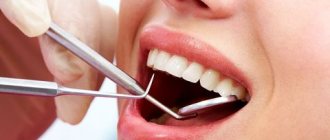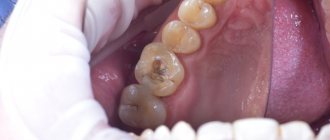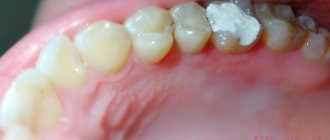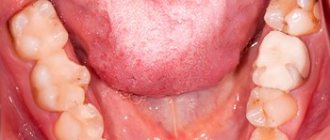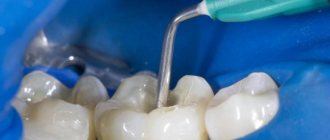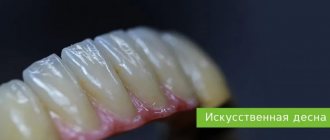In dental practice, there are often cases of advanced caries when a patient comes with complaints of acute toothache. If a doctor diagnoses pulpitis, then one of the stages of its treatment will be the installation of a temporary filling. It protects the canal from food and bacteria entering it. It should cover the exposed area of the tooth until treatment is completed by filling the canals and installing a permanent filling. In addition, the “temporary solution” is also relevant for a number of other pathologies.
Normally, the temporary “protection” is removed by the dentist. But there are situations when it falls out on its own. Why? Various factors can provoke this. But no matter what causes the temporary filling to fall out, it is important to know what to do in this situation and how to prevent complications from developing. After all, the consequences can be very unpleasant - from the spread of infection to the loss of a unit.
Signs of a filling falling out soon
How can you tell if a filling has fallen out? This is quite simple - at the place of its installation there is no material with which the filling was made, and there is a hole. Therefore, it is better to prevent such a phenomenon and contact a specialist in advance, even before complete loss.
Determining that the filling does not stay in the tooth and will soon fall out is also quite simple. Gaps appear between the tooth surface and the filling material, which are almost invisible at first, but become larger over time. The material itself becomes loose. This is felt when you press the seal with your tongue. If such phenomena are observed, you should immediately consult a doctor so as not to be annoyed later that the filling has come out.
Drugs placed under a sealed barrier
The service life of the temporary plug initially depends on the drug put into it:
- Arsenic is used to kill the nerve in the tooth for subsequent depulpation. For this purpose, a number of other toxic substances are used, which help not only to painlessly remove the nerve, but also to subject the entire pulp tissue to necrosis;
- To treat periodontitis or pulpitis, antiseptics or antibiotics are used to relieve inflammation. Such a filling is usually worn for about 20 days until the infection is completely suppressed.
Necessary actions if a filling falls out
It is important to know what to do if a filling falls out. It is advisable to immediately make an appointment with a dentist, but in some cases it is not possible to urgently visit a doctor. When a filling has come out of a tooth, you can do without it for a short time, but only for a certain time.
If treatment is delayed, the tooth may become infected, leading to acute pain and gradual destruction. It is important to visit a specialist in a timely manner, regardless of whether the filling is permanent or temporary.
But it is better to avoid such a situation and visit the dentist at the stage of loosening. Any gap or even minimal gap between the tooth and the filling is a place for bacteria to enter.
And if you don’t pay attention to such a problem in time, then you shouldn’t be surprised that the filling has fallen out between the teeth.
Most often, such troubles occur with molars. They experience a lot of stress and the filling material can be destroyed if you often eat solid foods. Fillings on the front tooth fall out much less frequently.
What to do?
Of course, you need to see a dentist. But the patient does not always have the opportunity to urgently leave work. In addition, many people believe that there is nothing wrong with a filling falling out and are in no hurry to visit the dentist.
When the doctor places a filling, he notifies the patient about what materials are used and for how long it is installed. It is important to remember this, because if the doctor used arsenic-based paste to kill the nerves, then one should not hesitate in case of material loss. This substance is poisonous! If it gets on the mucous membrane, it causes a burn, and if swallowed, it causes poisoning, gastrointestinal upset, and the development of an allergic reaction.
Therefore, if the patient notices a hole in the tooth, he needs to thoroughly rinse the oral cavity with a soda solution (dissolve 1 teaspoon of soda in 1 glass of warm boiled water and add a few drops of iodine). After this, you need to cover the hole with a sterile gauze swab and go to the doctor.
If the dentist filled the canals and installed a temporary filling, but it fell out, this is not so dangerous. After all, there is no toxic substance inside the tooth and infection will no longer penetrate into the canals. But you still need to visit a dentist to solve the problem. The doctor will conduct an examination and decide what to do - put a temporary filling again or replace it with a permanent one.
We recommend remembering the following algorithm of actions:
- If the filling falls out while eating, it is better to spit out the chewed food. After this, you need to rinse your mouth with an antiseptic (Chlorhexidine, Miramistin) or a soda solution. If you don't have this on hand, you can use mouthwash or clean water.
- You should not try to close the hole with chewing gum or other improvised means, or pick out the remnants of the filling material. There is a risk of damaging the mucous membrane or leaving a piece of the used “tool” in the hole, which will provoke the development of the inflammatory process. Do not try to insert a painkiller or antibiotic tablet into the hole. It won't help.
- Before eating, it is necessary to cover the damaged unit with a sterile gauze pad and minimize the load on this side of the jaw. Be sure to rinse your mouth thoroughly after every meal.
- If pain bothers you, you can take a non-steroidal anti-inflammatory drug, for example, Nurofen, Trialgin, Ketanov, etc. The recommended duration of taking these medications without medical supervision is no more than 3 days.
- As a result, in any case, you need to make an appointment with the dentist and have your tooth treated.
It should be remembered that you should not put off visiting a doctor until later. This is fraught with the development of an inflammatory process and may lead to the need to remove the unit.
Pain after a filling falls out and other unpleasant consequences
Simple recommendations for patients on what to do when a filling falls out and a tooth hurts:
- You need to rinse with a solution of baking soda and salt.
- You can take a painkiller, it could be Ketanov or Analgin.
- During the inflammatory process, the temperature may rise. It must be knocked down after exceeding 38.5° C. For this, antipyretics are used.
- If there is bleeding from a tooth, you should immediately consult a doctor. There can be many reasons for this phenomenon, and it will be possible to accurately determine the possible problem only after an appropriate examination.
You can find many tips on how to numb a tooth at home, but the most effective option is to rinse and take appropriate medications.
When a filling with arsenic falls out, you need to carefully remove the remaining medication with a cotton swab and rinse the tooth cavity with a soda solution.
How does the replacement work?
When the medicine under the protective “barrier” stops working, a permanent filling is installed. Using a drill, the doctor removes the remaining temporary material. Then it carries out antiseptic treatment of the opened tissues. Makes sure there are no complications and then places the permanent material.
All manipulations are carried out in one visit to the doctor. They are usually comfortable and do not require the use of painkillers - after all, the inflammation has already been cured and the nerve has been removed.
Is it possible to close a hole in a tooth yourself?
The question often arises as to what can be used to seal a temporarily opened cavity if a filling falls out. People use a wide variety of materials for these purposes - from cotton wool to chewing gum, in general - everything that can be used to fill a hole at home. Under no circumstances should this be done. Before you tape a tooth, you should think about the consequences. The cavity will not be closed hermetically, which means food debris and bacteria will get into it.
Before you think about how to plug a tooth at home, it is worth considering that any material will create extremely favorable conditions for the proliferation of microbes and the occurrence of infection or inflammation. Therefore, the question of how to cover the tooth should not arise. To avoid the accumulation of food debris in the cavity, it should be rinsed regularly at least 6-7 times a day.
Rules of care
A temporary “barrier” is less durable than a permanent one. He is able to cope with the chewing load for up to two to three weeks. If you "carry" it, it will collapse or fall out. In this regard, until the dentist replaces it with a permanent one, it is important to follow the following rules:
- Avoid eating too solid foods. Nuts, crackers, seeds, etc. are prohibited.
- Do not use chewing gum or sticky candies.
- Carry out hygienic cleaning twice a day - in the morning and in the evening after meals. Use only a brush with soft bristles.
- Do not use a paste containing abrasive particles during treatment.
- After each meal, hygienically rinse the mouth with warm water.
By keeping these rules in mind, you can significantly reduce the likelihood of destruction of the established composition.
Treatment process
People faced with such a problem are interested in how the tooth will be treated when the filling has fallen out. It all depends on individual characteristics, so it is worth considering the most common situations.
If the carious cavity is too large, it makes no sense to fill it again. The material will not hold and will fall out again after a short time. Therefore, the doctor will suggest alternative methods of eliminating the defect, most likely installing a crown.
If repeated caries occurs, pulpitis or other diseases develop, they must first be cured. The doctor prescribes and carries out all the necessary measures and, after complete recovery, places a new filling. If the filling material falls out of a pulpless tooth, re-filling is often also ineffective. In this case, the specialist will recommend installing a pin.
Methods for restoring the integrity of a tooth depend on its condition, so it is difficult to suggest a treatment plan without a preliminary examination.
Removal and replacement for permanent
Removing the temporary plug is a mandatory procedure before installing a permanent structure. Usually removal is done after the end of treatment, removal of the nerve, so it does not cause pain. There may be slight discomfort, but it goes away after a couple of minutes.
After removing the filling, the dentist must clean the root canals and treat the tooth with an antiseptic. After all measures have been taken, the tooth can be considered ready for permanent filling.
Lost temporary filling
What to do when a temporary filling falls out? It is placed to fix the medicine in the tooth cavity and prevent the entry of saliva, food debris and microbes. Arsenic, which is poisonous, is used as a medicine. Therefore, if such a situation arises, a number of measures need to be taken:
- carefully examine the tooth cavity and determine whether the medicine remains there;
- if it remains, carefully remove it with a cotton swab;
- make a warm soda solution (at the rate of 1 teaspoon of soda per glass of water);
- rinse the tooth cavity thoroughly.
When the canals are sealed, the loss of a temporary filling does not cause significant discomfort, but leaving the tooth as is is prohibited. It can be destroyed under the influence of various factors. For a filling to fail, there must be significant reasons and only a specialist can eliminate them.
If a filling with arsenic falls out immediately after visiting a specialist, you need to make a second appointment as soon as possible and have it restored. If there are several days left until the next scheduled appointment, you don’t have to reschedule it and visit the doctor when it’s scheduled. Only a dentist can tell you how long you can walk without a filling, so it’s a good idea to call and get a consultation.
Choosing temporary filling material: proceed without mistakes
Every practicing dentist knows how important the correct selection of filling material is for effective treatment. Modern dentistry offers a huge selection of materials, which are divided into classifications depending on composition, properties, time of use, purpose, etc. A fairly large place among them is occupied by a group of filling materials for temporary fillings, as well as insulating and therapeutic pads.
Materials for temporary fillings
Based on the time of action, they are divided into bandages and temporary fillings. Inexpensive materials are used for dressings. The most common option: water-based dentin or dentin-paste. The period of use of these materials should not exceed 14 days. At the same time, the bandages do not differ in aesthetics and durability. All temporary fillings are cements : zinc phosphate, zinc eugenol, polycarboxylate, glass ionomer, etc. The period of their use in the patient’s oral cavity ranges from several weeks to six months.
1) Zinc sulfate cements (“artificial dentin”)
The main components of the composition are zinc sulfate and zinc oxide. Adding water helps the mass harden. The most famous materials of this group: “Dentin for dressings”, Dentine paste, Vinoxol, etc.
2) Zinc-eugenol cements
The basis of the composition is zinc oxide and eugenol. According to Smith's classification (1996), this subgroup includes three main types of cements: simple zinc oxide eugenol; reinforced zinc oxide eugenol with filler and cements based on orthoethoxybenzoic acid (EBA). The materials consist of zinc oxide powder, into which 1-2% zinc acetate, acetic anhydride or rosin are added, which accelerate hardening. Purified eugenol or clove oil is used as a solvent. Additionally, to speed up the hardening process of cement, acetic acid or 1% ethyl alcohol, as well as a small amount of water, can sometimes be added. The most popular representative of this group is Cariosan. Zinc-eugenol cements are used not only for temporary fillings , but also for therapeutic linings. It is important to take into account that eugenol disrupts the polymerization process of composites, so experts do not recommend using this type of cement in combination with them. That is why today zinc-eugenol cements are practically not used for therapeutic linings in commercial clinics, but they are still in demand in pediatric dentistry and in municipal clinics for the treatment of deep caries in two visits.
3) Zinc phosphate cements
75-90% of the cement base is zinc oxide with the addition of other modifying oxides. The liquid part is an aqueous solution of 38-44% orthophosphoric acid containing phosphates of zinc, aluminum, magnesium, etc. Among the most famous zinc-phosphate cements presented on the Russian market are: Phosphate cement from Raduga-R, Uniface ( “Medpolymer”), Adgesor (“Dental Spofa”), DeTreyZinc from “DeTrey/Dentsply”, etc. As a rule, metals containing silver are added to these compositions to impart a bactericidal effect. As an example, we can o), Phosphate with silver and bactericidal Foscin (“Rainbow-R”), as well as cements containing bismuth oxides: Visphate cement and Dioxyphosphate (Medpolymer).
The undoubted positive properties of these cements are: ease of use, low thermal conductivity, good X-ray contrast, and impermeability to acids and monomers. However, they have quite a lot of negative characteristics. Among them: weak adhesion, low resistance to the aggressive effects of saliva, shrinkage, low mechanical strength, the presence of free acid and lack of aesthetics.
Most often, zinc-phosphate cements are used as an insulating spacer for filling baby teeth and permanent crowns, fixing cast stump inlays, pins, crowns and bridges.
4) Polycarboxylate cements
The basis of cement is thermochemically treated zinc oxide with the addition of magnesium oxide, which reduces the reactivity of the first component. Aluminum is also often added to powders. The solvent is represented by a 32-42% aqueous solution of polyacrylic acid. During the hardening process, cement turns into an amorphous zinc-polyacrylate gel, which contains zinc oxide particles.
The positive properties of these cements include: satisfactory chemical adhesion to enamel and dentin, strong bond with metals, weak toxicity to the pulp compared to phosphate cement and high biocompatibility with tooth tissues. Negative properties: high solubility under the influence of saliva, short formation time in the oral cavity and insufficient fluoride adhesion.
Polycarboxylate cements are used as insulating spacers when filling teeth under artificial crowns, for fixing orthopedic and orthodontic structures, and in the treatment of baby teeth (1-2 years before their replacement).
All materials for temporary fillings must be:
- harmless to the pulp;
- have high plasticity;
- inactive for other drugs;
- insoluble under the influence of saliva;
- sealed for at least two weeks;
- have a certain strength;
- easily removed from the dental cavity using an excavator, probe or drilling.
Insulating and healing pads
The purpose of these materials follows from their name. Despite the fact that they can be conditionally classified as filling materials, the application of gaskets is an integral step in the treatment of medium and deep caries. spacers when treating medium and deep caries . They contain calcium hydroxide, which has an anti-inflammatory effect on the pulp and stimulates the deposition of replacement dentin. Among the most popular materials are: “Calmecin”, “Dycal”, “Calcimol” and “Alcaliner”, as well as modern insulating gaskets made from glass ionomer cements, such as: “Fuji 2”, “Chelon Fil”, “Base Line” and etc.
Today the following requirements apply to insulating gaskets:
- reliably protect dentin from chemical and temperature irritants;
- easy to install;
- withstand the effects of saliva when the filling is damaged;
- withstand chewing load;
- have good adhesion to tooth tissues;
- do not have an aggressive effect on the dental pulp;
- do not affect the color of tooth enamel.
Therapeutic pads have an anti-inflammatory, regenerating and analgesic effect, therefore they are used in the treatment of deep caries. They are characterized by good ductility, the material hardens quickly. Basically, the therapeutic component of modern medical pads is calcium hydroxide, which has a bactericidal effect and shifts the pH environment in the tooth cavity to the alkaline side, which ensures neutralization of acids. The base material can be polymer, water-based, oil-based or monomeric. Dentists use either ready-made medicinal pads or prepare them themselves. The use of a therapeutic pad significantly reduces the risk of the formation of microcracks and the development of secondary caries. However, with all their advantages and positive effects on the pulp, these compositions have noticeable disadvantages:
- low adhesion to dentin, which determines the weak adhesion of the filling to the tooth tissues;
- lack of resistance to the aggressive effects of saliva, which creates conditions for further infection;
- accidental contact of gasket particles with the walls of the formed cavity can lead to secondary caries.
It is recommended to apply therapeutic pads in cases where the bottom of the formed cavity is located too close to the pulp. It is believed that in order to prevent infection of the pulp by toxins, the minimum thickness of the dentin layer should be 2 mm. When placed correctly, the therapeutic material completely covers the bottom of the carious cavity or lies pointwise in the areas where the pulp horns adjoin. In this case, it is necessary to carefully remove it from the walls of the cavity in order to avoid disruption of the adhesion of the filling material and the development of secondary caries.
Regardless of their purpose, all temporary filling materials must meet the same clinical requirements:
- do not have a toxic effect on the enamel, dentin and pulp of the tooth, as well as mucous membranes;
- be harmless to the body as a whole;
- have antiseptic, anti-inflammatory and anti-caries effects;
- be chemically inert and resistant to aggressive environments such as alkalis and acids;
- have sufficient adhesion to dental tissues, mechanical strength and wear resistance;
- do not change the color of the tooth and do not lose its original color over time;
- do not cause the appearance of galvanic currents in the oral cavity;
- do not change shape and volume during hardening;
- have good radiopacity.
For an experienced specialist, purchasing filling material, like any other dental consumable, usually does not cause any particular difficulties. However, the dental market, being one of the most dynamic and rapidly developing areas of global business, is constantly changing, which makes it difficult to keep track of new products and truly profitable offers in a timely manner. Today, the marketplace of the Internet portal “Dentists Club” is rightfully considered one of the most reliable and positively proven resources. This aggregator has been successfully operating in the dental market since 2017 and has already proven itself as a proven and honest partner. At the same time, the Dentist Club market is the only aggregator of offers in the field of dentistry today, which allows you not only to purchase the necessary goods at the guaranteed best prices, but also in addition to receive a cashback of 1.5% back to your account!
What other benefits does the Dentist Club market provide?
1. Time saving
- You don’t need to go to all the search results sites to find what you need
- There is no need to call companies and try to explain to them over the phone what you need
- No need to send a request and wait for managers of trading companies to answer or call you back
2. The Dentist Club Market service helps when communicating with doctors
- You can easily find the desired product by description and photo
- Determine the desired model and its modification
- Check all these parameters directly with your doctor and get his approval
- Place an order in one click.
3. Lowest prices on the market guaranteed
- You can simultaneously see the prices of all companies offering the required product
- Compare the prices presented and choose the most profitable one
- The manager of the selected company will call you back. He doesn’t need to explain ten times what you need, because... He sees all the necessary information in the generated order.
- And don't forget about cashback!
4. 100% order security
- Absolutely all companies - suppliers of dental equipment and consumables, collaborating with the marketplace, have already been checked for legal purity by lawyers of the Dentists Club. That is why all purchases made on the Dentists Club market are absolutely reliable!
5. Ease of use
- You can install the Dentist Club Market service on your phone so that it is always at hand. Open the app, find the products you need, and order. Everything is quick, accessible and simple. Application in the App Store on iPhone (iOS) or on Google Play for Android.
Aida Levasheva – senior nurse at the dental clinic (Samara):
“To be honest, purchasing dental supplies was my least favorite job until recently. I do not have a dental education, and until recently this created certain difficulties. Of course, before purchasing, I asked doctors what material was more convenient for them to work with. The problem was that everyone had their own preferences. I had to search for what I needed all over the Internet, compare prices, and call managers of trading companies for half a day to find out the terms of payment and delivery. This often took almost the entire working day. And in the end, the head physician, looking at the list and prices, crossed out half of the points. The Dentist Club Market was recommended to me by one of my classmates at medical school. I really liked the resource. For me, the most important thing is a very convenient and simple interface, which you can easily understand even without a dental education. I especially liked the function where you can compare prices for the desired product! If you need professional advice, you can get it directly on the website and immediately pay for your order there. All this is very convenient and saves a lot of time!”
Go to Market >>>
Loss of fillings in children
When a child’s filling falls out, you should not ignore the problem, even if the teeth are baby. Caries and other diseases can provoke severe pain and the development of an inflammatory process.
What to do if a temporary filling falls out of a baby tooth:
- Call your doctor, consult and make an appointment as soon as possible.
- Ensure that your child maintains good oral hygiene.
- Rinse your teeth regularly to remove food debris.
Important! Fillings on baby teeth fall out for various reasons, and only a specialist can determine what causes this phenomenon. So, in any case, you cannot do without a visit to the dentist.
Why use it - indications for use
Dentists install temporary filling compounds for:
- Advanced caries. If the cavity is very deep, after it has been cleansed of the affected tissue, a medicinal solution is applied to make the layer between the open area of the crown and the dentin as strong as possible.
- Progressive acute pulpitis. Requires depulpation. For this purpose, a medicine is placed into the “hole” that destroys the nerve. It is covered with a protective insulating compound, which will be replaced in the future.
- Periodontitis. With this disease, progressive inflammation in the root area is observed. To stop it, the dentist puts an antiseptic medicine inside the canals. To securely fix it, a hardening gel is placed on top.
- Complicated carious process. Sometimes dentists are faced with a non-standard course of a diagnosed disease. Then, in order to select an effective treatment, they decide to observe the dynamics. In this case, there is no point in installing a permanent element - it will most likely have to be removed soon. Therefore, preference is given to the temporary.
- Manufacturing of dental crowns and bridges. After impressions are taken, it is important to protect the sawn parts of the unit. To do this, use a temporary filling or crown.
Sometimes non-permanent filling is used during the sanitation of dental canals. This is necessary to prevent recurrence of the treated disease. The specialist thoroughly cleans all intradental areas, then applies an antiseptic and closes it on top for a certain period of time. During repeated appointments, he uses permanent hardening mixtures.
Filling falling out during pregnancy
When a temporary filling falls out during pregnancy, this is a reason to urgently consult a dentist. Many women worry that treatment may negatively affect the course of pregnancy. Women carrying a child are certainly at risk, but doctors are well aware of the acceptable limits of exposure. If necessary, the doctor will select the optimal method of intervention so as not to harm the body.
You need to treat your teeth anyway. Carious lesions are an ideal environment for the development of pathogens that can cause much more harm to a pregnant woman than the process of restoring a diseased tooth.
If a filling falls out at the end of pregnancy - in the 3rd trimester, the doctor may postpone treatment if serious intervention is necessary to restore the tooth. In most cases, the specialist will make do with minimal temporary treatment, and will carry out complex measures carried out under anesthesia after childbirth.
How to prevent the development of caries?
The best treatment for any disease is prevention. Therefore, instead of reminding yourself every time how to properly fill your teeth yourself or looking for a good specialist for this, it is better to try to prevent their further destruction. What can be done?
Nutrition. Natural foods should dominate the diet, and various sweets and flour products should be excluded. Particular attention should be paid to products high in fluoride and calcium. The temperature of food consumed should not be too high or low.
Taking proper care of your teeth
Hygiene. Disinfection of the oral cavity should be carried out after every meal. You shouldn’t limit yourself to just toothpaste and a brush, because using dental floss and mouthwash increases your chances of maintaining healthy teeth.
Installing a dental filling yourself at home is a good alternative to going to the dentist. However, it is important to remember that this method is not always possible. It is suitable only for the simplest cases of dental damage.
Destruction of the seal
Has the filling broken? This is evidence of its gradual destruction. This phenomenon can occur for various reasons. The main ones:
- Too much zeal when carrying out hygiene procedures. Frequent use of a hard brush can cause damage to the filling material or enamel.
- Large loads on the tooth. They occur when eating solid foods, seeds, nuts and the like.
- Poor quality filling material.
- Failure of a specialist to comply with the technological process.
What to do if a piece of the filling breaks off and your tooth hurts? This indicates that the material does not adhere tightly to the surface and a gap has arisen between the filling and the tooth. Pain is a consequence of the inflammatory process. If the pathology is not eliminated, it will develop and cause various diseases.
If a filling breaks on a dead tooth, a crown will have to be placed in any case. If a problem arises on a front tooth that is still alive, the doctor will suggest depulping it and then installing a crown as well.
How long do you need to wear a filling?
You can wear a temporary filling for a period of one day to six months. The maximum validity period of Vinoxol, the strongest and most durable of them, is exactly 6 months. However, such fillings are placed quite rarely, and in general their shelf life depends on their original purpose.
If medicine was placed under the cork, the period will be from 3 to 20 days. In general, the timing of removing the temporary barrier depends entirely on the treating dentist.
Important! You should not wear a temporary filling in your mouth for a longer period than recommended by your doctor, even if it is in perfect order.
Types depending on material
A temporary filling is made of plastic, water-insoluble materials. They are selected taking into account the condition of the diseased tooth and the purpose of installation.
- Dentine paste. Protects teeth from staining with amalgams and has water-repellent properties. Not for use with liquid medications. Hardening time – 2 hours. Service life – 7-10 days.
- Vinoxol. It has high strength and can maintain integrity for up to six months. Thanks to its antiseptic properties, it disinfects the tooth cavity. Hardening time – up to 4 hours.
- Artificial dentin. Zinc sulfate cement is installed for up to 3 days. Before installation, the tooth must be thoroughly dried, because it does not harden in a humid environment.
- Nice. May be pink and white. White teeth are most often filled with non-pulpless teeth. Pink filling compound is suitable for covering arsenic or cotton swab. Does not cause irritation.
- Polycarboxylate cement. It has high strength and biocompatibility. Used for filling permanent and baby teeth, fixing dentures.
- A mixture of zinc oxide and eugenol. It has a sedative effect and disinfects the cavity well. Resistant to chewing loads. Hardens within 12 hours.
